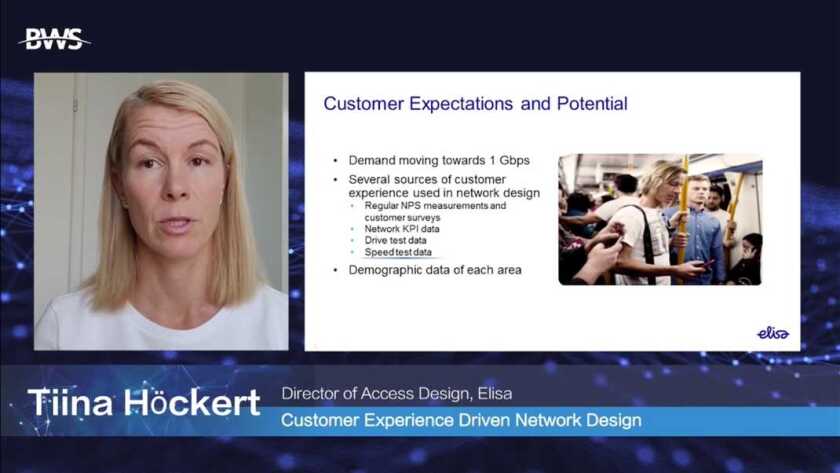Elisa, which provides mobile services across Finland, was the first in the country to start commercial 5G services – and it was also the first in the Nordic countries to sell a 5G handset, as long ago as July 2019.
The company has taken a customer experience-driven approach to network design, says Tiina Höckert, Elisa’s head of access design.
She has worked for Elisa since 1994 and moved to her current role in early 2020, responsible for network design, mobile network construction and business co-operation.
“I work as a head of network design which in fact is quite a narrow description of my responsibility areas. I’m developing the 5G strategy of our company in cooperation with our business people and I work to ensure great customer experience for users of our current networks,” she notes.
Finland has only 5.5 million inhabitants over a large area – a population density of 17 people per square kilometre, she points out in Huawei’s Better World Summit, being held online in September.
Finland has “the most eager mobile data users in the world” says Höckert. “And Elisa is the number one in mobile and fixed networks in Finland.”
In her presentation at Huawei’s Better World Summit NetX 2025 and X-Tech, she talks about the input sources for network design, including Elisa’s network strategy, the customer expectations and potential, and the third party interests and inputs.
Elisa has recorded a number of firsts in the year since it sold the first 5G phone in July 2019. At almost the same time it became the first company in the world to offer 5G roaming, thanks to a deal with Swisscom. The company has 90% coverage of Switzerland. Swisscom’s 5G customers can also use Elisa’s 5G network in Finland.
Elisa has also focused on Finns’ expectations at home: in March this year it expanded its 5G network to the Ruka ski resort in Kuusamo, a major centre for winter sports.
The 5G network in Kuusamo covers the Ruka village and the area near the front slopes, close to many of the restaurants and services. In the north the network reaches over Lake Talvijärvi towards the village of Salmilamminkylä. Almost million travellers visit Ruka every year and are now able to benefit from the fast 5G connections.
Elisa’s network strategy was to select the best possible and most suitable technology for each area, with a target of providing the best 1Gbps coverage in Finland.
This meant optimising network assets, Höckert said at the Better World Summit, minimising overlapping coverage and optimising the utilisation of the access network – which is, after all, her speciality.
There will be a clear ramp-down plan for legacy technologies, she said.
The company announced in March 2020 that it is focusing on 5G and 4G network technologies to respond better to the user needs of today and the future. The use of 3G networks by Elisa customers is already very limited – and will further decrease. After 2023, the frequencies used by the 3G network will be freed up for use by the 4G network.
There will be limited effect on customers, as most devices work on 4G, with only a few payment terminals that are 3G-only. Elisa has decided to focus primarily on the development, expansion and increase in capacity of its 4G and 5G networks.
After 2023, customers who have a telephone, for example, that supports 3G will automatically be transferred to the 2G network. The 2G network will continue as before.
But what are customer expectations, asks Höckert. Clearly they are wanting to move to 1Gbps, and to this end Elisa has developed several sources of customer experience used in network design. These include regular net promoter score (NPS) measurements and customer surveys. It gathers network key performance indicator (KPI) data, along with drive test data and speed test data.
And it matches all that with demographic data for each area.
Other interests have to be taken into account, notes Höckert. There are new buildings to consider, and new residential and industrial areas.
At a more detailed level, there are changes in site infrastructure, including the endings of rental agreements and the dismantling and renovation of buildings. Above all, there are changes in legislation and in the requirements set by the authorities.
For all this, Elisa uses customer and value-oriented network analysis and design, bringing together Elisa’s strategy customer expectations, customer base and customer potential, as well as third-party interests and inputs, plus demographic data.
Add into that a calculation on the return on investment that can be achieved.
“And as a result we have a country-wide view of the optimal access technology to guide high-level access network planning,” says Höckert, “and the customer potential to be used in marketing and sales.”
She notes: “Even though I’ve spent the most of my career in the same company, the only constant thing has been change. During my career I’ve been working both with well-established business lines and start up ideas. I’ve been in front line meeting the customer and at the other end of the process: building the foundation for service.”
Elisa will continue to be a leader in 5G network roll-out in Europe.
Sponsored entry





